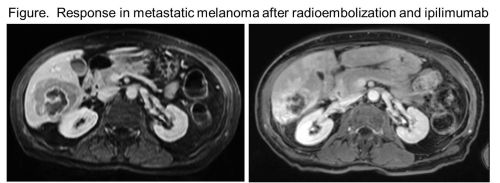|
Back to 2015 Annual Meeting Program
Synergistic Effects of Radioembolization and Ipilimumab in Metastatic Melanoma to the Liver
Yun Shin Chun*, Srinevas K. Reddy, Joseph Leach, Subbarao Inampudi, Eduardo Ehrenwald, Timothy Sielaff
Virginia Piper Cancer Institute, Minneapolis, MN
Background: Ipilimumab is an anti-cytotoxic T lymphocyte antigen-4 (CTLA 4) monoclonal antibody that potentiates immune response to cancer and is associated with improved survival in patients with metastatic melanoma. Fractionated radiotherapy is postulated to enhance antitumor immunity and has been shown to exert synergistic effects with ipilimumab, including regression of metastatic melanoma distant from the primary site of radiotherapy. The effects of radioembolization of hepatic metastases in patients treated with ipilimumab have not been described previously.
Methods: A retrospective review was conducted of a prospectively maintained database of patients undergoing radioembolization with yttrium-90 microspheres for primary and secondary hepatic malignancies at a single tertiary referral center. Patients were treated with SIR-Sphere® between the years 2008-2011 and TheraSphere® from 2012-2014. Radiographic response was determined by the Response Evaluation Criteria in Solid Tumors, version 1.1.
Results: Fifteen patients underwent radioembolization for liver metastases from melanoma, including 4 patients with cutaneous melanoma and 11 with ocular melanoma. The median interval between diagnosis of primary melanoma and liver metastases was 28 months (range, 0-324 months). The median overall survival from date of diagnosis of liver metastases was 15 months (95% confidence interval, 12-18 months). Eight of 15 (53%) patients received additional treatment for their liver metastases, including systemic chemotherapy (n=2), chemoembolization (n=1), radiofrequency ablation (n=1), mitogen-activated protein kinase (MEK) inhibitor (n=1), anti-programmed cell death-1 (anti-PD-1) antibody (n=1), and ipilimumab (n=2). After radioembolization, 10/15 (67%) patients experienced disease progression, 1 (7%) patient had stable disease, and 4 (27%) patients had partial response. Both patients treated with ipilimumab and radioembolization exhibited partial response in the liver (figure) but subsequently developed extrahepatic progression. On univariate analysis of prognostic factors, including serum lactate dehydrogenase, interval from primary tumor diagnosis to liver metastases, percent of liver replaced by tumor, tumor size and number, the only factor significantly associated with radiographic response to radioembolization was receipt of ipilimumab (p=0.042)
Conclusion: In this preliminary report of patients with hepatic metastases from melanoma, treatment with radioembolization and ipilimumab was associated with significant response in the liver, but an abscopal effect was not observed.

Back to 2015 Annual Meeting Program
|


